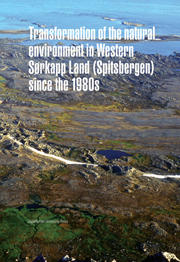Book contents
- Frontmatter
- Contents
- Introduction
- Study area
- Methods and materials
- Components of natural environment
- Environmental and landscape changes
- Climate warming
- Glacial recession
- Transformation of landforms and Quaternary deposits
- Changes of water drainage and networks
- Changes in vegetation
- Conclusions and prognosis for environmental change
- References
- List of enclosures (maps)
- Plate-section
Changes in vegetation
from Environmental and landscape changes
Published online by Cambridge University Press: 05 September 2014
- Frontmatter
- Contents
- Introduction
- Study area
- Methods and materials
- Components of natural environment
- Environmental and landscape changes
- Climate warming
- Glacial recession
- Transformation of landforms and Quaternary deposits
- Changes of water drainage and networks
- Changes in vegetation
- Conclusions and prognosis for environmental change
- References
- List of enclosures (maps)
- Plate-section
Summary
Plant communities in 1982–1985
The making of phytosociological maps of Arctic areas is difficult because of incomplete knowledge about tundra plant communities. One of the problems is mosaic vegetation made up of many different communities occupying small areas. Available vegetation maps usually show the distribution of physiognomic types of tundra (CAVM Team 2003) or the distribution of plant communities on a large scale (Elvebakk 2005).
A detailed vegetation map catalogues plant communities in a given area and shows their extent and geographic location. The phytosociological map of northwest Sørkapp Land (Dubiel, Olech 1991), which was the basis for the current comparative study, was made on a 1 : 25 000 scale. Mapping was preceded by making a series of relevés according to the classic Braun-Blanquet method and creating phytosociological tables enabling the identification of plant communities. Detailed phytosociological research resulted in the selection of 28 plant communities, which were clearly distinguished phytosociologically and were visible in the field. The aim of the research was not to define the precise syntaxonomic position and names of the communities in question. The results included a vegetation map, which would be the basis for further comparative studies on vegetation changes in the area, and the characterization of the plant communities identified during the research.
A group of plant communities associated with dry habitats was identified based on relief and water conditions.
- Type
- Chapter
- Information
- Transformation of the Natural Environment in Western Sorkapp Land (Spitsbergen) since the 1980s , pp. 69 - 82Publisher: Jagiellonian University PressPrint publication year: 2011



